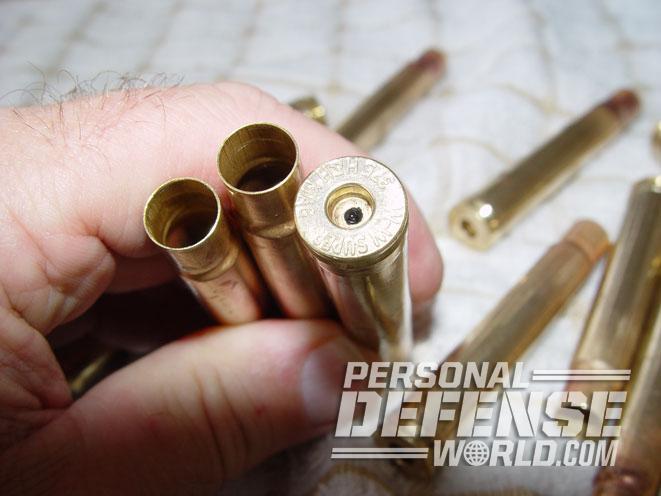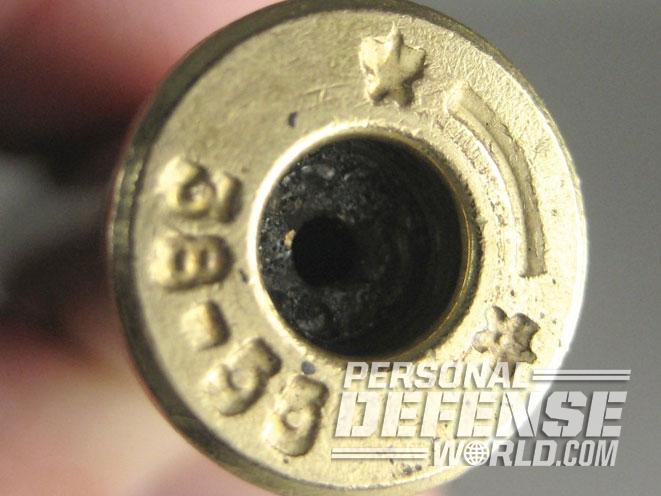Like many shooters, I take a great deal of pride in how my gear functions, looks and feels. On occasion, when I have accidentally scratched or marred the finish on one of my prize rifles or shotguns, that injury is felt just as much as if I’d injured my own body. And that pride of ownership carries over to my ammunition as well. I’ve always liked my cartridge cases to gleam and shine. I suppose there is some validity in the fact that a clean cartridge case feeds and functions better than a dirty one, but aside from that I simply like the looks of untarnished handloads that look brand new.
When my wife and I first got married, more years ago than I like to think about, we didn’t have a great deal of money to spend on such equipment as a tumbler for polishing my cartridge cases. But that didn’t hinder my desire to keep my brass shiny, and to do that I frequently used steel wool, Brasso- soaked rags and a great deal of elbow grease to remove the grunge from my cartridge cases. Eventually I found a way to purchase my first tumbler and enjoyed the fact that I could finally pack away the steel wool and Brasso. But innovations continue to improve the way we handload our cartridges, and now there is an even better method of brass polishing that not only cleans the tarnish and contaminants off the outside of the cartridge cases, but the inside as well.
Ultrasonic cleaning has been used for decades by mechanics to remove grease and gunk from their machinery and auto parts, and jewelers use that same technology to clean rings, necklaces and other fine quality jewelry. But that technology seemed to have been slow to get a foothold within the shooting and handloading community until recently. Lyman may have been one of the first companies to adopt ultrasonic technology for cleaning cartridge cases, but now the company offers several models in varying sizes specifically intended for that purpose. A couple of other companies have since followed suit and now offer their own ultrasonic cleaning systems, but I personally feel that the Lyman Turbo Sonic ultrasonic cleaner remains one of the best.
Advertisement — Continue Reading Below
Ultrasonic Cleaning

High-frequency sound waves that are actually above the normal range of human hearing are the basis behind ultrasonic cleaning. Those sound waves are injected into a heated bath of liquid cleaning medium in which the contaminated parts are held. As a result, the liquid becomes agitated and bubbles start to form on the surface of the cleaning solution, causing the dirt, corrosion, fouling, oils and greases and other contaminants to be released from the surface of the metal. For cleaning brass cartridge cases, Lyman recommends using its own Turbo Sonic Concentrated Cartridge Case Cleaning Solution. But you can also clean other types of materials, such as stainless steel, anodized aluminum and even in some cases jewelry and other items like gun parts in that same Lyman system by simply substituting Lyman’s Concentrated Steel & Gun Parts Cleaning Solution. One word of caution is in order here, however: If you intend to use the system for cleaning other items like fine jewelry, it is strongly recommended that you read the instructions that come with the unit very carefully. Cleaning such things as silver, sterling silver and silver plating is not recommended, and you should also avoid submerging any gemstones in the cleaning medium.
Lyman’s Turbo Sonic
Advertisement — Continue Reading Below

The Lyman model I personally use is the company’s midsized Model TS 2500, which comes with a tank size of 2.6 quarts. The chemicals used for the system are available from Lyman in various sizes ranging from single-use packets up to economy-sized 1-gallon containers. When cleaning brass cartridge cases, typically the concentrate is mixed at a rate of 0.5 to 1 ounce in 20 ounces of water. The company recommends using distilled water, but I have on occasion substituted normal well water and felt it worked just fine.
RELATED STORY: Tool of the Trade – Lyman’s Electronic Digital Trigger Pull Gauge
Advertisement — Continue Reading Below
One of the nice things about the Lyman units is how easy they are to use. Once the cleaning solution has been mixed and placed in the cleaning tank, the wire basket containing your brass should be lowered into the unit. In order for a proper and thorough cleaning to take place, all of the cartridge cases must be completely submerged below the surface of the liquid. For operational control, there are only four buttons to contend with, which are labeled “On,” “Off,” “Set” and “TC.” The “Set” button determines the length of the cleaning cycle from 180 to 480 seconds, and the “TC” button is essentially the on and off switch for the heating element. In the cleaning process, the fluid will eventually become murky in appearance, and at that point the tank should be drained and replenished with a fresh batch of cleaning solution.
You can even operate the ultrasonic cleaner using only clean water and without any chemical additives, but of course the results may not be as impressive when it comes to removing heavy tarnish and corrosion. In some cases when cleaning particularly dirty items, a pre-cleaning cycle involving only hot water can be beneficial prior to the actual chemical cleaning.
Tumbling Vs. Ultrasonic
Advertisement — Continue Reading Below

When using the dry tumbling method to polish your brass, it usually does an acceptable job of cleaning off the normal tarnishing that occurs. Unfortunately, that cleaning is restricted only to the outside of the cartridge cases. In this case, as the tumbling process begins, a portion of the cleaning medium quickly penetrates the inside of the cases and primer pockets, where it remains throughout the entire cleaning cycle. The result is that those areas do not get cleaned at all and come out just as dirty and contaminated as they were at the beginning of the cycle. I have sometimes found the primer pockets to be packed so tightly with cleaning media that I must resort to using a small screwdriver to dislodge it.
In addition, it generally takes me several hours of constant tumbling to get even lightly tarnished brass looking new again. And maybe it is because I’m getting older and like my quiet time, but the constant droning of a tumbler working has a tendency to get to me over time. To compensate, I frequently have to isolate the tumbling operation out of my area of hearing.
Advertisement — Continue Reading Below
RELATED STORY: New For 2015 – Lyman Product’s Media Separator
When it comes to ultrasonic cleaning, however, the noise level is monumentally less and the cleaning process is considerably shorter. To achieve an adequate degree of cleaning on the exterior of the brass, a tumbler will likely run for several hours. On the other hand, Lyman indicates that its Turbo Sonic only typically requires 10 to 15 minutes to get the job done. I have found on occasion that sometimes an additional five minutes is needed for particularly dirty brass.
The biggest disadvantage that I have found with ultrasonic cleaning systems is the fact that they are liquid-based units. Essentially, this means that you must be extremely careful to ensure that your brass is completely bone dry before attempting to reload it. I suppose you could speed up the normal ambient drying process by placing your brass on a cookie sheet and then sticking it inside your kitchen oven with the heat turned down to its lowest setting. Other than that I would recommend that you never clean your brass ultrasonically if you need to reload the cartridges quickly. I have on occasion spread the cases out on the open hearth in front of my woodstove or placed them on a towel in the direct sunlight in hopes of speeding up the process, but whatever drying method you decide to employ, be certain that the brass is completely dry on the inside before you begin the reloading process.
Advertisement — Continue Reading Below
Available Models

Lyman currently lists three Turbo Sonic models that are specifically intended for cleaning cartridge cases. My own unit is the moderately sized Model TS 2500, which has a capacity to clean up to 900 9mm or 400 .30-06 cases and carries an MSRP of $143. There is also a smaller Model TS 1200 that can hold up to 350 9mm or 150 .30-06 cases and retails for $120. The largest is the Model TS 6000 for $370, which can clean up to 1,300 9mm or 650 .30-06 cases, or it can even be used to clean up to three good-sized pistol frames.
RELATED STORY: Lyman Ammo Checkers – A Must for An Easy and Consistent Feed
Advertisement — Continue Reading Below
I may not put my tumbler in our next garage sale just because I own a Lyman Turbo Sonic ultrasonic cleaner. On the other hand, if I didn’t already own the tumbler, I believe it would an easy decision to simply own a single device for cleaning my cases, and in that case it would likely be one of Lyman’s Turbo Sonic ultrasonic cleaners.
For more information, visit http://www.lymanproducts.com or call 800-632-2020.






































